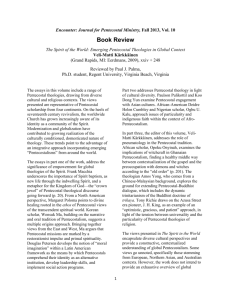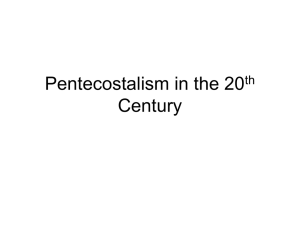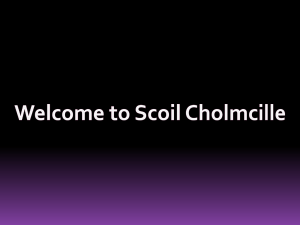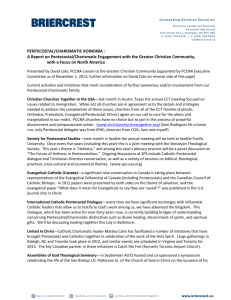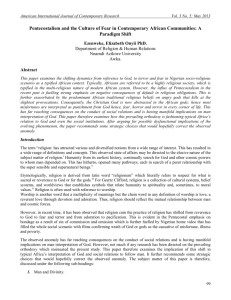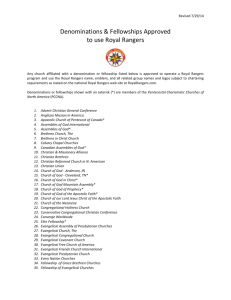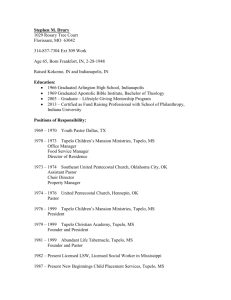Mulu Wongel Church: Mission, Pentecostalism, Ethiopian Identity
advertisement
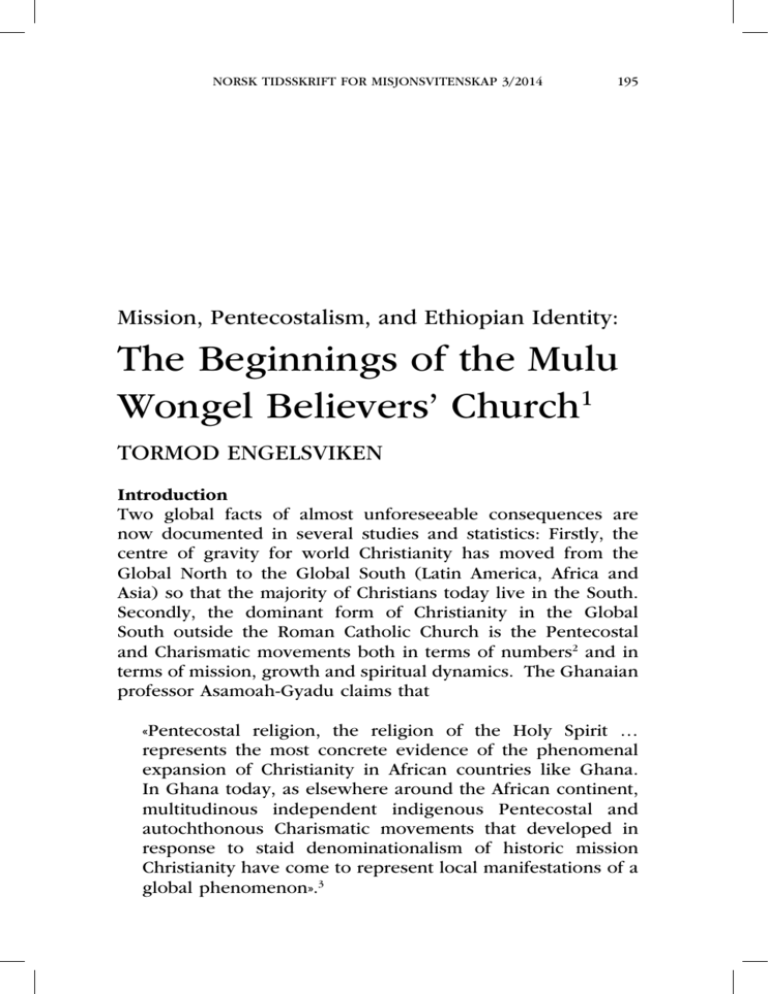
NORSK TIDSSKRIFT FOR MISJONSVITENSKAP 3/2014 195 Mission, Pentecostalism, and Ethiopian Identity: The Beginnings of the Mulu Wongel Believers’ Church1 TORMOD ENGELSVIKEN Introduction Two global facts of almost unforeseeable consequences are now documented in several studies and statistics: Firstly, the centre of gravity for world Christianity has moved from the Global North to the Global South (Latin America, Africa and Asia) so that the majority of Christians today live in the South. Secondly, the dominant form of Christianity in the Global South outside the Roman Catholic Church is the Pentecostal and Charismatic movements both in terms of numbers2 and in terms of mission, growth and spiritual dynamics. The Ghanaian professor Asamoah-Gyadu claims that «Pentecostal religion, the religion of the Holy Spirit … represents the most concrete evidence of the phenomenal expansion of Christianity in African countries like Ghana. In Ghana today, as elsewhere around the African continent, multitudinous independent indigenous Pentecostal and autochthonous Charismatic movements that developed in response to staid denominationalism of historic mission Christianity have come to represent local manifestations of a global phenomenon».3 196 NORSK TIDSSKRIFT FOR MISJONSVITENSKAP 3/2014 Most researchers of African Pentecostalism seem to have been largely unaware of the developments in Ethiopia. Today Ethiopia has several Pentecostal churches with high numbers of members. Moreover, large Protestant churches such as the Ethiopian Evangelical Church Mekane Yesus (EECMY) and the Kale Heywet Church (KHC) with more than 12 million members are heavily influenced by the Pentecostal and Charismatic movements. The first independent indigenous Pentecostal church in Ethiopia was the Full Gospel Believers’ Church (hereafter caller the Mulu Wongel Church) which was established in the mid 1960s as a result of a Pentecostal revival. Several Ethiopians have written about this church in a historical perspective, and this historiography has recently been the subject of a thorough doctoral dissertation written by the German Jörg Haustein based on extensive research in Ethiopian sources.4 In some ways the Mulu Wongel Church is unique in an African setting, and it is also immensely important in that it has given the impetus to the formation of other Pentecostal churches as well as inspired the Charismatic movements in the more traditional mainline churches. In this essay we will therefore look at the initial phase of the independent Ethiopian Pentecostal church Mulu Wongel (MW), its beginnings with Western missionaries in the early 1960s and the establishment as an independent Ethiopian church in the mid-1960s. It will especially highlight the relationship between the emerging Ethiopian church and the expatriate missionaries in terms of leadership structure, theological profile and ecclesial and missional practice, a relationship that was both cooperative and characterized by conflict. It will also take into account the influence of other African Pentecostal movements in the initial phase and how this influenced the development of the Mulu Wongel Church. An overarching perspective will be the relationship between a commitment to the Pentecostal doctrine and experience that are largely common for so-called classical Pentecostal churches everywhere and thus create a global Pentecostal identity, and an emphasis on the truly Ethiopian character of the Pentecostal church and its members. Finally the article wishes to draw some NORSK TIDSSKRIFT FOR MISJONSVITENSKAP 3/2014 197 lines to the present time offering some suggestions as to the major factors behind this growth. Personal Research History In order for the reader to understand my own interest in and perspective on research related to the Pentecostal movement in Ethiopia, I would like to share some personal information. As a member of the Church of Norway, which is a Lutheran state church with about 80% of the Norwegian population as baptized members, I am not a Pentecostal or a representative of the Pentecostal movement. After graduating with a degree in theology in Norway in 1969 and some further post-graduate studies, I went in 1971 to the Mekane Yesus Seminary in Addis Ababa as a teacher of systematic theology. I stayed in Ethiopia until 1973. During this period I got into contact with the Mulu Wongel church and due to my interest in this church and in Pentecostalism in general, I was asked by the then general secretary of the Mekane Yesus Church, Rev. Gudina Tumsa, to investigate the Pentecostal movement in Ethiopia which had become a challenge both doctrinally and practically to the Mekane Yesus Church in many areas, and report back to the church officers and later to the EECMY General Assembly in Yirga Alem in 1973. This I did, and this formed my initial encounter with and evaluation of the the Mulu Wongel church.5 With a scholarship from the Lutheran World Federation I pursued my doctoral degree in the USA 1973-1976 on the topic of the Lutheran charismatic movement then spreading through many Lutheran churches worldwide, including the Church of Norway.6 During these years in America I was able to complete a first history of the Mulu Wongel church besides my doctoral studies. The 225 p. manuscript that was finished in 1975 was titled Molo Wongel. A Documentary Report of the Life and History of the Independent Pentecostal Movement in Etiopia 19601975. The manuscript was never published, the reason being that I thought it was not at that point suited for publication as I felt some areas of research remained unexplored. It was also not a strictly scholarly work since my intention was to call attention to and create sympathy for this church that at the time was under persecution. However, through this manuscript 198 NORSK TIDSSKRIFT FOR MISJONSVITENSKAP 3/2014 I was able to document the first 15 years of the Pentecostal movement in a way that had not been done before. The manuscript was based on extensive personal interviews with leaders of the Mulu Wongel church as well as other church leaders in Ethiopia. Many of the interviews were conducted in Ethiopia by a close colleague of mine, Rev. Knut Sigurd Aasebø, who as a missionary working with students at the Haile Selassie I University had unique contact with the student leaders of the Mulu Wongel church. I owe a great debt to Rev. Aaasebø for his work of collecting some of the material. My unpublished manuscript was distributed to several libraries in the US and Norway, and a copy was handed over to the leadership of the Mulu Wongel church during a meeting in the Wabe Shebelle Hotel in Addis Ababa in 1976. This manuscript became the basis for or an important ingredient in many later theses or other scholarly works on the Pentecostal movement in Ethiopia. Haustein says about the document, «The scope of the document, its availability in the relevant institutional contexts, and its relative singularity due to the lack of early historical writings made it the single-most referenced source in all histories of Ethiopian Pentecostalism».7 The main strength of this manuscript was that it built on information from informants who were very close to the events, both in terms of time – most of the interviews were done in 1973 and 1974 – and in proximity to the events themselves – most of the informants were Pentecostal leaders and central actors in the history they told about. As I have continued my study8 on Ethiopian Pentecostalism since finishing the first manuscript I find myself in the rather peculiar situation that many of my sources actually build on and are referring explicitly or implicitly to my early work from 1975. In critiquing their use of sources I find myself sometimes critiquing my own initial work. Nevertheless, I am convinced that main story as told in the 1975 manuscript stands and forms a solid base on which to enter a discussion of other aspects of Ethiopian Pentecostalism. In this paper I also build on this early manuscript and draw some perspectives and conclusions from it related to more recent discourses on Pentecostalism. NORSK TIDSSKRIFT FOR MISJONSVITENSKAP 3/2014 199 Experience and doctrine There is an old debate going on in Pentecostal scholarship about the relationship between doctrine and experience in the Pentecostal movement.9 There is no doubt that a defining characteristic of at least classical Pentecostalism is an experience of the Holy Spirit that is commonly called «baptism in the Spirit». This experience has been accompanied by a doctrine primarily based on the Book of Acts that has included two parts, the first being the doctrine of subsequence. According to this doctrine the experience of Spirit baptism with the aim of power for missionary witness is seen as subsequent to elements of Christian initiation such as conversion/regeneration and water baptism. It is a separate experience sought separately subsequent to salvation as a second stage. The second doctrine was that speaking in tongues is the initial evidence of Spirit baptism. The pioneer of Pentecostal studies, Walter Hollenweger, has included as Pentecostals «all the groups who profess at least two religious crisis experiences (1. baptism or new birth; 2. baptism of the Spirit), the second being subsequent to and different from the first, and the second usually, but not always, being associated with speaking in tongues».10 The experience of Spirit baptism and the doctrine of Spirit baptism are closely related, but what exactly is the relationship? It has been argued that experience has priority and that «experience has preceded their hermeneutic» or that Pentecostals «first experience something, then rush to the scripture after the fact to reach for a rationale for what has happened to them». This is a common complaint against Pentecostals, says the Pentecostal writer William Menzies.11 However, it can be argued, in my opinion convincingly, that there is a closer mutual relationship in which the experience is a result of a faith expectation and prayer based on a certain interpretation of biblical texts, a doctrine, which then is confirmed or validated by the experience itself. There is a mutual interdependence between experience and doctrine in which one confirms the other as valid.12 This relationship is documented by Pentecostal historian 200 NORSK TIDSSKRIFT FOR MISJONSVITENSKAP 3/2014 Vinson Synan who shows that the beginning of Pentecostalism as an identifiable movement with both experience and doctrine can be traced to a Bible school in Topeka, Kansas, USA on New Year’s eve 1900, where students and the leader of the school, Charles F. Parham, experienced baptism in the Spirit with the initial evidence of speaking in tongues after having arrived at the abovementioned interpretation of the relevant texts in the Acts of the Apostles dealing with Spirit baptism and speaking in tongues.13 Later the experience of Spirit baptism has not been exclusively tied to glossolalia but has been seen as a more comprehensive experience of the Holy Spirit. This understanding is expressed by Asamoah-Gyadu, «Pentecostalism refers to Christian groups which emphasise salvation in Christ as a transformative experience wrought by the Holy Spirit and in which “pneumatic” phenomena including “speaking in tongues”, prophecies, visions, healing and miracles in general, perceived as standing in historic continuity with the early church as found especially in the Acts of the Apostles, are sought, accepted, valued, and consciously encouraged among members as signifying the presence of God and experiences of his Spirit ».14 This definition does not, however, fully bring to expression the distinction between salvation and the experience of the Spirit, and the subsequent aspect of the experience which was so important for the early Pentecostals, and was part of their appeal to people who were already converted to Christ, to pursue the next stage, namely Spirit baptism. Historical background What is today called Classical Pentecostalism can, as we have seen, trace its history as an identifiable historical entity back to this early beginning of the 20th century. The seminal Pentecostal movement did not, however, come to public attention until 1906 when a series of meetings in Azusa Street, Los Angeles, California, USA, under the leadership of the black evangelist William C. Seymour (1870-1922) erupted into a NORSK TIDSSKRIFT FOR MISJONSVITENSKAP 3/2014 201 huge revival drawing crowds and catching the attention of the national media. Both the message and the behaviour of the early Pentecostals challenged the existing traditional churches, and although the movement originally wanted to remain as a renewal movement within the established churches, it was soon forced out and had to establish itself as several new Pentecostal denominations. Some of these denominations consisted mainly of relatively poor people of Afro-American background while the one that grew to be the largest was called Assemblies of God and was predominantly white. The missionary fervour of the Pentecostal believers showed itself almost immediately and within a few years the movement had spread beyond the North American continent to other continents such as Europe, Latin America and Africa. It became particularly important in South Africa under the name Apostolic Faith Mission. The «apostle» of Pentecostalism to Europe was the Norwegian Thomas B. Barratt (1862-1940) who originally had been a Methodist pastor but converted to Pentecostalism in 1906 and began Pentecostal work in Norway, a work that through visits and missionaries spread to the rest of Scandinavia and Germany. My thesis is that the Mulu Wongel Church in Ethiopia at the same time is a church deeply influenced by and belonging to the larger international Pentecostal movement, and a uniquely Ethiopian church. I want to place it in this larger international context by looking at its early history and the relationship between experience and doctrine. There are mainly three sources of international influence on the early Ethiopian Pentecostal movement; firstly Swedish and Finnish Pentecostal missionaries, secondly the Bible and Pentecostal literature of various kinds mostly originating in America, and thirdly African Pentecostalism represented primarily by the Kenyan evangelist Chacha Omahe.15 The missionary factor The origin of Pentecostalism in Ethiopia can be traced back to Finnish and Swedish Pentecostal mission.16 Many of the Pentecostal/Charismatic churches or forms of Christianity in the Global South do not have a link to American or European 202 NORSK TIDSSKRIFT FOR MISJONSVITENSKAP 3/2014 Pentecostal mission or influence, but are rather the results of indigenous developments where local worldviews with larger affinities to biblical worldviews than the modern Western worldviews have given much of southern Christianity a Pentecostal or charismatic flavour, with emphasis on supernatural healing, visions, prophecies, dreams, exorcism etc. Thus not all Pentecostalism or Pentecostal-like phenomena can be traced back to Western sources of influence.17 However, when we deal with Pentecostalism in Ethiopia due emphasis must be placed on the role of foreign missionaries. Haustein very interestingly has pointed out how almost all historical narratives of the beginning of Pentecostalism mention the missionaries, but that their place and significance vary. He adds me to the Ethiopian historians who primarily give them a preparatory role and put most emphasis on the independent character of the Mulu Wongel Church, while the Pentecostal missionaries themselves in their historical and autobiographical accounts give the foreign missionaries a much larger and continuing role.18 The Finnish and Swedish Pentecostal movements had come into being in their home countries early in the 20th century. In Sweden the Pentecostal revival arrived already in early 1907 through the Norwegian pioneer Thomas B. Barratt who again was influenced by the Azusa Street revival in America. It spread rapidly through Sweden and became the largest free church movement in this predominantly Lutheran nation. The revival was closely related to the influence of Anglo-American forms of Christianity that had already been noticeable before the arrival of the Pentecostal movement. Doctrinally Swedish Pentecostalism belonged to the same tradition as the Assemblies of God in America with emphasis on Spirit baptism and the initial evidence of glossolalia.19 The structure of the Pentecostal movement was congregationalist where each congregation was independent. This also applied to the extensive mission work. The missionaries were sent out and financed by individual congregations, and also reported back to them about the progress of the work. The history of Pentecostalism in Finland also goes back to Thomas Ball Barratt who visited Finland in 1908, but the first Finnish Pentecostal congregation was not founded until 1915. NORSK TIDSSKRIFT FOR MISJONSVITENSKAP 3/2014 203 The Finnish Pentecostal movement also has a heavy emphasis on international mission, organizing its work through the organization Fida International (formerly Finnish Free Foreign Mission) founded in 1927, today the largest mission and development organization in Finland, and also the largest in Europe with a Pentecostal background.20 Yet, as in Sweden due to the congregationalist structure individual congregations were responsible for the mission. The first Finnish Pentecostal missionaries arrived in Ethiopia in 1951 and eventually developed a work in the Merkato area of Addis Ababa from 1956 primarily under the leadership of the female missionary Helvi Halme. This centre became important for the early independent Pentecostal movement as some of its most prominent leaders had been active in this mission.21 The Swedish Pentecostals began their work in Ethiopia in 1959 and the pioneer missionary Karl Ramstrand set up a mission in Awasa, the capital of Sidamo province in Southern Ethiopia.22 Several missions were already active in Sidamo, particularly the Norwegian Lutheran Mission (NLM) and the Sudan Interior Mission (SIM). In terms of general theological profile the Pentecostal missionaries could be characterized as Evangelical and as such it did not differ much from other Evangelical Protestant foreign missions in Ethiopia when it came to the most central theological tenets. There would of course be different views of the doctrine and practice of baptism, of church structure etc., but these were divisions well known and accepted among Evangelical missionaries. The new and unique doctrine that set the Pentecostal missionaries apart was their view of the Holy Spirit, and more particularly their view of Spirit baptism as a subsequent experience with glossolalia as initial evidence. Along with this message went also the promise of an experience of the Spirit that would be tangible and life transforming and would give the recipient a new power for ministry as well as other spiritual gifts such as healing and prophecy. It was this message that attracted large numbers of Ethiopian youth to meetings and conferences in Addis Ababa and Awasa. While the Pentecostal movement in many countries has been a movement for and by the poor who then only slowly 204 NORSK TIDSSKRIFT FOR MISJONSVITENSKAP 3/2014 have risen socially, economically and educationally to become middle class («redemption and lift»), most of the people who were initially attracted to and active in the Ethiopian Pentecostal movement were young students who did not belong to the poorest sections of society but were relatively privileged as high school and university students. Their conversion to Pentecostalism could therefore hardly be explained in terms of social deprivation theories. It is significant that most of the early adherents to the Pentecostal church had been members of other Ethiopian churches, such as e.g. the Mekane Yesus Church, the Baptist Church or the Ethiopian Orthodox Church. They joined the Pentecostal movement not with the intention of becoming Christians but of becoming better, Spirit-baptized Christians. So it was the uniquely Pentecostal message that attracted the young people. Although the Swedish Pentecostal mission in Awasa combined development and mission work, it was the conferences or Bible schools held in Awasa each summer beginning in 1962 that were to become the most important means of recruitment, drawing hundreds of Ethiopian youth from many parts of Ethiopia. The preachers most often belonged to the mission staff, but also invited speakers from abroad would preach the Pentecostal message at these conferences. We shall return to one of them. The Impact of Reading Pentecostal Literature There was very little Christian literature of a Protestant persuasion originally written in or translated into Amharic or any other Ethiopian language, and next to nothing as far as I have been able to ascertain – of a more Pentecostal or charismatic kind in the 1960s and early 1970s. However, there was Christian Pentecostal literature available for the young people interested in Pentecostalism. It was all in English and consisted for the most part of pamphlets, journals and books that were distributed by the missionaries or later ordered free of charge from publishers in America. In my opinion it is difficult to overestimate the impact of literature on the minds of young people who have just achieved literacy in a largely illiterate society, and who were able to master a new language NORSK TIDSSKRIFT FOR MISJONSVITENSKAP 3/2014 205 that gave them almost unlimited access to the writings of major international Pentecostal personalities. This may have opened a new religious world to the young Christians far beyond the borders of Ethiopia and the kind of Christianity that they had encountered there. The theological quality and historical reliability of some of this literature could be of a very doubtful nature. It would contain claims that went far beyond reality, yet the Ethiopian readers had very few resources to assess critically what they read. They would eventually feel that they were part of a world- wide movement of immense spiritual significance. I would argue that it probably was this literature, even more than the teaching of the missionaries that would give them their identity and self-understanding as an Ethiopian revival movement in the larger context of the global Pentecostal movement. In certain respects the written word would have an advantage over missionaries’ words in conveying values, views and attitudes. In Ethiopian Christian culture there has been a great respect for the written word. This can be seen primarily in the enormous demand for Bibles, and the undisputed authority of the Biblical texts. It must have been a great discovery for many to recognize some of the Pentecostal tenets in the Biblical passages. It might be safe to assume that some of this respect for the Bible also was transferred to the Pentecostal literature that was read by the religiously inquisitive young people. The information given by the Mulu Wongel leaders confirm the significance of literature, especially in the preparation of the revival. This is also evidenced by the remarkable similarity between the emerging Ethiopian Pentecostal movement and the international Pentecostal movement, primarily the Assemblies of God kind of classical Pentecostalism. The way the Biblical passages that were of particular importance to Pentecostalism were understood must to a large extent have been informed by reading of foreign literature. The Pentecostals’ interpretation of their own expectations and subsequent experiences of what their church and ministry might look like may have been equally inspired by Pentecostal literature. Both the doctrinal and ecclesial profile of the young Mulu Wongel Church can be discerned in the literature that fed it during its formative years. 206 NORSK TIDSSKRIFT FOR MISJONSVITENSKAP 3/2014 This observation may at least lead to two conclusions: Firstly, the Mulu Wongel Church did not at the beginning develop any local contextual theology or practice; neither did it introduce anything that might be regarded as «heretic» or aberrant in relation to traditional Pentecostal doctrine and practice. It was doctrinally «orthodox» in the broad meaning of the word. Secondly, the foreign literature, combined with a certain Biblical interpretation, provided the young believers both with a doctrine that would give them expectations of what they might experience when they were «baptized with the Spirit», and simultaneously an interpretive framework to deal with the experiences when they eventually occurred. This combination of a doctrinal framework understood to be biblically based and a corresponding spiritual experience gave the Pentecostal believers a deep assurance and conviction which again resulted in power in their ministry as witnesses to Christ and later also boldness in facing resistance and persecution. The African factor Strangely enough some of the early Ethiopian Pentecostal leaders complained that the Scandinavian missionaries were too cautious when it came to sharing their view of Spirit baptism and trying to facilitate the experience of it to their Ethiopian followers. This aroused the suspicion that the missionaries wanted to keep the experience for themselves, or that it was not for Ethiopians.23 There is a well-known pattern where the Pentecostal experience of baptism in the Spirit follows periods of fervent preaching of its reality and significance, intensive prayer for it by its potential recipients and intercession with laying on of hands by leaders who already have experienced this gift. The seeming reluctance of the missionaries to pray for the Ethiopian seekers was replaced by very bold preaching and practice by the Kenyan evangelist Chacha Omahe who was invited to Ethiopia in 1963 and later, and who participated both in the Swedish Mission Bible conference in Awasa and in meetings in the Finnish mission in Addis Ababa.24 He exhibited an authority that would challenge that of the missionaries, NORSK TIDSSKRIFT FOR MISJONSVITENSKAP 3/2014 207 and a boldness in dealing with spiritual matters that deeply impressed the Ethiopians. Through his ministry many came into the experience of Sprit baptism with the accompanying gifts of glossolalia. In their accounts of the significance of Chacha Omahe, my Ethiopian sources emphasize that he was an African and therefore in some respects closer to the Ethiopians than the missionaries. The fact that he also had had the Pentecostal experience confirmed for the Ethiopian believers that this experience was also for Africans. What emerged after Omahe’s visits was a more self-confident and bold Ethiopian movement, both due to the Pentecostal experiences many individuals had received and the confirmation of the movement as an African or Ethiopian movement. The Process of Independence The Ethiopian identity of the emerging Pentecostal movement was, as mentioned earlier, not due to any particularly Ethiopian contextual features as far as Pentecostal theology was concerned.25 It was more related to church practices and church leadership. We could have discussed the role of long and intensive prayer and the development of Ethiopian indigenous music and song as two areas where particular Ethiopian features came to expression, yet we will concentrate on one area only: the question of leadership. One of the reasons why the leadership question came to be important may be the fact that among the early Ethiopian Pentecostals there was a considerable number with relatively high education and significant personal intellectual and spiritual resources. They were not willing to take on a subservient role in relation to the missionaries in the long term, but insisted that they be given a leadership role in the emerging revival movement, especially with regard to preaching and teaching during Sunday services. Some resented especially what they saw as a monopolization of the pulpit by Finnish, and particularly female missionaries, in the Merkato mission.26 The process of achieving full independence from the Finnish and Swedish missions was a complex one,27 but the outcome was the emergence of a national Ethiopian Pentecostal church with all the marks of an independent church. These marks include 208 NORSK TIDSSKRIFT FOR MISJONSVITENSKAP 3/2014 the so-called «three self»: self-governing, self-propagating and self-supporting.28 The Ethiopians were aware of this principle, having learned about it from the Swedish mission that viewed it as a goal for their work. This also means that the Swedish mission had a basic positive attitude towards the efforts aiming at independence. In my opinion it is primarily in this deliberate attempt to be an Ethiopian church without dependence on foreign mission in terms of finance, church governance and evangelism that the Ethiopian identity of the church may be found. After the break with the missions and the establishment of the Mulu Wongel Church, the Ethiopian Pentecostal believers might still have a good relationship with the missionaries but on an equal basis and not on one of dependency. It was in this establishment of an Ethiopian church independent of the missions that the Ethiopian identity of the church came to most vivid expression. As a church the Mulu Wongel would also need to have an ordained leadership. The reasons were both pragmatic and theological. The growth of the church, and the workload caused by its many activities made it impossible to base all the work on informal voluntary leadership. One needed leaders that could be identified and be responsible. Secondly, it was theologically justified by reference to the Pauline practice in the New Testament.29 Haustein discusses the role of the missionaries in the ordination of the first elders.30 My sources suggest that the reason for inviting missionaries to pray for those who had been elected elders by the Ethiopians was to follow the Pauline pattern. It gave legitimacy to the ordination but did not imply dependence. Later ordinations of elders were to be performed by the Ethiopians themselves without the assistance of foreign missionaries. Thus the involvement of missionaries in the initial ordination did not jeopardize the independence of the Mulu Wongel church from the missions. On this background of independence it came as a great disappointment that the church’s application for registration in 1967 as an Ethiopian church was turned down and the activities of the church deemed illegal.31 It would not be recognized as an Ethiopian church such as the Ethiopian Orthodox Church, nor would it be recognized on a par with churches associated NORSK TIDSSKRIFT FOR MISJONSVITENSKAP 3/2014 209 with foreign missions. The later history of persecution during the final years of the Haile Selassie I’s regime, the even more severe persecution under the Derg period are described elsewhere, as is the history of the church during the last 25 years of freedom.32 Conclusion: Reasons for Pentecostal growth There has been great scholarly attention paid to the reasons for Pentecostal growth worldwide. Various social sciences such as sociology, anthropology, and psychology have offered their answers as have historians of religion and theologians of various persuasions. It is not possible to discuss the various theories here, but we agree with the African researcher Ogbu Kalu who argues that the attractiveness of the Pentecostal movement is not due to anything other than the central marks of Pentecostalism itself. He warns against what he calls «monocausality», that is: to emphasize only one reason for growth, «We avoid the cardinal sin of monocausality and apply four explanatory discourses: the historical, cultural, instrumentalist and religious ».33 Theories by historians, sociologists and anthropologists have often been functionalist or instrumentalist where they explain the growth of Pentecostalism by its ability to promise solutions or actually solve problems or meet needs that are not in themselves religious.34 This often implies a reductionistic approach where secondary economic, social, political and psychological factors, often connected to certain deprivation theories, are seen as the main reasons. In our opinion it is the central characteristics of Pentecostalism, both its doctrinal framework and its experiential character that makes it appealing to people with a religious orientation to life. Most of those attracted to Pentecostalism in its initial phase did already belong to other churches and were Christians by any definition. The search for an experience of a God who intervenes in human affairs, changes people and situations and provides deep and satisfactory answers to existential questions 210 NORSK TIDSSKRIFT FOR MISJONSVITENSKAP 3/2014 led them to Pentecostalism.. From a Christian perspective, for the moment leaving aside “methodological agnosticism”, one may regard the growth of Pentecostal Christianity as a result of the work of the Holy Spirit in the world. Differently said: The growth of Pentecostalism and the charismatic movement can only be understood and explained under the perspective of religious faith. This does not mean that there might not also be other perspectives and factors that may contribute as partial explanations to the overall explanation of growth. Among the religious factors that have been highlighted are what has been called «progressive Pentecostalism» emphasizing the expression of care and love, the diaconical aspect of Pentecostalism.35 Others have pointed to the relationship to African Traditional Religion and shown that Pentecostalism in certain respects share the world view of ATR when it comes to acknowledging the reality of the spiritual world. In the fight against dark destructive spiritual forces, the proclamation that Christ has power over all evil, that he is Christus Victor, and that the Spirit-filled Christian can live a victorious life, has strong appeal. Asamoah-Gyadu says about the Pentecostals,36 «Through their experiential spirituality they are successfully mediating the sacred, bringing God to people and conveying the self-transcending and life-changing nature of Pentecostal religion in an African setting in a way that resonates with African traditional spirituality». William Kay argues the obvious that Pentecostal churches grow because they are Pentecostal. He refers to research that documents that churches «in which an abundance of charismatic gifts is manifested tend also to be evangelistic and attractive to newcomers…There is a correlation between church growth and congregational charismatic activity».37 Interestingly, Kay draws the same conclusion that I have tried to argue for many years, «Our assumption is that ultimately it is the marriage between NORSK TIDSSKRIFT FOR MISJONSVITENSKAP 3/2014 211 theology and experience that makes Pentecostalism what it is… If, as Pentecostals believe, the Holy Spirit continues to be poured out in the twenty-first century, we will see yet more innovations in the years to come».38 There is no reason to believe that the study of Pentecostal and Charismatic movements, whether in Ethiopia and in other African countries, will be less urgent and relevant in the years to come. I am satisfied that these movements have been placed on the agenda of an increasing number of sciences, and look forward to a fruitful dialogue between theology and other sciences about this contemporary religious challenge. When the story of Ethiopian religion and culture in the late 20th and in the 21st century is written, the Pentecostal and Charismatic movements have to occupy a prominent place. 212 NORSK TIDSSKRIFT FOR MISJONSVITENSKAP 3/2014 Noter 1 This article was presented to a panel on Pentecostalism led by Jörg Haustein at the International Conference on Ethiopian Studies (ICES) in Dire Dawa 2012. Due to unforeseeable circumstances the author was not able to be present at the conference. This version is a slightly revised one. 2 See e.g Paul Jenkins, The Next Christendom (Oxford: Oxford University Press, 2002). According to the most recent statistics 612 mill .Christians are today included in the category «Pentecostals, Charismatics and NeoPentecostals», and the prognosis is that the number will rise to 828 mill. by 2025, cf. International Bulletin of Missionary Research, Vol. 36, No. 1, January 2012, p. 29. 3 See J. Kwabena Asamoah-Gyadu, African Charismatics. Current Developments within Independent Indigenous Pentecostalism in Ghana (Leiden: Brill, 2005) p. IX. 4 Jörg Haustein, Writing Religious History. The Historiography of Ethiopian Pentecostalism (Wiesbaden: Hararassowitz Verlag, 2011). Unfortunately I have only recently been able to read the book and I regret that I am not able to make full references to all aspects of Haustein’s important work. 5 This story is also told in Jörg Haustein’s study Writing Religious History. The Historiography of Ethiopian Pentecostalism. (Wiesbaden: Harrassowitz Verlag 2011) pp. 23-24. 6 The study resulted in the dissertation Tormod Engelsviken: The Gift of the Spirit. An Analysis and Evaluation of the Charismatic Movement from a Lutheran Theological Perspective, Unpublished doctoral dissertation, Dubuque, Ia, 1981/Aquinas Institute of Theology, St. Louis, Miss, 1981. 7 Haustein, Writing Religious History, p. 24 8 After almost 40 years I have nearly completed a second, more scholarly documented and argued manuscript which I hope will be published in the relative near future. In it I have deliberately tried to fill some of the lacunae and omissions that for reasons of limited time were unavoidable in the first document. 9 A good overview over the debate about experience and doctrine with references to significant literature can be found in e.g. Stephen E. Parker, Led by the Spirit. Toward a Practical Theology of Pentecostal Discernment and Decision Making (Sheffield: Sheffield Academic Press, 1996), pp. 20-31. 10 Walter J. Hollenweger, The Pentecostals. The Charismatic Movement in the Churches (Minneapolis, Minn.: Augsburg Publishing House, 1972), p. xix. 11 Quoted in Parker, Led by the Spirit, p. 21 12 In my doctoral dissertation I have shown how this relationship applies to both so-called classical Pentecostalism and the later charismatic movement taking its beginning from the US in 1960. See Tormod Engelsviken, The Gift of the Spirit, (Dubuque, Ia.:Aquinas Institute (unpublished doctoral dissertation), 1981), pp. 1-32. NORSK TIDSSKRIFT FOR MISJONSVITENSKAP 3/2014 213 13 See Vinson Synan, The Holiness-Pentecostal Tradition. Charismatic Movements in the Twentieth Century (Grand Rapids, Mi.: Eerdmans, 1997), pp. 90-92. 14 Asamoah-Gyadu, African Charismatics, p. 8. 15 Haustein correctly points out that I in 1975 had called him Omahe Chacha while his correct name is Chacha Omahe. My mistake was due to varying information in my Ethiopian sources, cf. Haustein, Writing Religious History, p. 69 16 There had been other Pentecostal missionaries in Ethiopia before the Finnish missionaries arrived in 1951 but as far as the Mulu Wongel Church is concerned only the Finnish and Swedish missionaries are mentioned by Ethiopians as being of importance, cf. Haustein, Writing Religious History, pp. 46-51. 17 In Ethiopia some of the charisms, or spiritual gifts, associated with Pentecostalism or the Charismatic movement, were known and practiced prior to and independent of the Pentecostal mission and churches. The Ethiopian Orthodox Church had e.g a tradition of prophecy where monks could bring prophetic messages even in large churches. In an article I have discussed how exorcism and healing were practiced in the Mekane Yesus Church prior to Pentecostal or charismatic influence. See Tormod Engelsviken: «Exorcism and Healing in the Evangelical Churches in Ethiopia», Journal of Mission Theology, Vol. 1, Fasc. 1, 1991, pp. 80-92. 18 Discussion and references are found in Haustein, Writing Religious History, pp. 37-51. In a master thesis the Norwegian scholar Line Onsrud demonstrates how local Kenyan leaders and foreign missionaries had very different views of the history of the East Africa Pentecostal Churches. She therefore argues for the right to “self-historizing” as part of the «self-theologizing» of churches in a non-Western context. See Line Onsrud, History and Contextualization. A Study of Church History and Cultural Identity in East Africa Pentecostal Churches as Narrated by Former and Present Leaders in the Church (Unpublished Master thesis at MF Norwegian School of Theology, Oslo, 1998). 19 Regarding the early history of Pentecostalism in Sweden, see e.g. Carl-Erik Sahlberg, Pingströrelsen och tidningen Dagen – från sekt til kristet samhälle 1907-1963 (Uppsala: Uppsala Universitet 1977) pp. 7-20. Sahlberg also documents how the new revival was exposed to heavy criticism both from church and secular quarters. 20 Se e.g Sari Hokkanen, «The Pentecostal Movement in Finland», www.uta. fi/FAST/FIN/REL/sh-pente.html. 21 See also Haustein, Writing Religious History, p. 55. 22 To the history of the Swedish Pentecostal mission in Ethiopia, see Gunilla Nyberg Oskarsson, Svensk Pingstmission in Ethiopien (1959-1980) (Huddinge: MissionsInstitutet-PMU, 1997); Haustein, Writing Religious History, p. 63. 23 Haustein, Writing Religious History, p. 77. 24 For a discussion of the person and role of Chacha Omahe, see 214 25 26 27 28 29 30 31 32 33 34 35 36 37 38 NORSK TIDSSKRIFT FOR MISJONSVITENSKAP 3/2014 Engelsviken, Molo Wongel , pp. 25-29, and Haustein, Writing Religious History, pp. 69-79. The confession of the Mulu Wongel Church from 1967 is almost identical with that of the Assemblies of God, Engelsviken, Molo Wongel, p. 124-125. There was also a gender issue in that both Ethiopian culture as well as the teaching of Swedish missionaries did not allow for prominent leadership roles for women, particularly as pastors. See Haustein, Writing Religious History, pp. 79-89. Haustein’s conclusion is interesting, «A number of theological positions regarding church organization, mission, Pentecostal identity, contextuality, and even gender roles are woven into these accounts as reasons for the separation», p. 89. These marks were developed by missiologists in the 19th century and have ever since been seen as a goal for church development in most Protestant mission, cf. David J. Bosch, Transforming Mission. Paradigm Shifts in Theology of Mission (Maryknoll, N.Y.: Orbis) p. 331. Texts that were referred to were Acts 14:23; Tit.1:5-9; 1 Tim. 3:1-13. Haustein, Writing Religious History, pp. 132-136. See Engelsviken, Molo Wongel, pp. 50-52, 61-65, Haustein, Writing Religious History, pp.138ff. See e.g Engelsviken, Molo Wongel, pp. 53-80, 142-213; Haustein, Writing Religious History, pp. 137-247. The persecution under the Derg-regime (1974-1991) was severe. Many Pentecostals survived spiritually in house churches and in other churches that were allowed to be open during this period, e.g, the Mekane Yesus Church. After the fall of the Communist regime in 1991 the Mulu Wongel Church was granted full freedom and continued to grow. Today it has several hundreds of thousand members and is one of the leading evangelical churches in Ethiopia. Ogbu Kalu, African Pentecostalism. An Introduction (Oxford: Oxford University Press), p. ix-x. Kalu, African Pentecostalism, p. xii. See Donald E. Miller and Tetsunao Yamamori, Global Pentecostalism. The New Face of Christian Social Engagement (Los Angeles: University of California Press, 2007). Asamoah-Gyadu, African Charismatics, p. 8. William K. Kay, Pentecostalism (London: SCM Press, 2009), p. 308. Kay, Pentecostalism, p. 309. NORSK TIDSSKRIFT FOR MISJONSVITENSKAP 3/2014 215 Tormod Engelsviken, professor emeritus in missiology, born 25.9.1943 in Norway, Cand. Theol. MF Norwegian School of Theology, Oslo, Norway, 1969, Ph.D. Aquinas Institute of Theology, Dubuque, Ia, 1981, teacher, Mekane Yesus Seminary, Addis Ababa 1971-1973, associate professor of missiology 19841998 and professor of missiology 1998-2013, MF Norwegian School of Theology. He has written books and articles on mission, biblical studies, Pentecostalism and religion.
